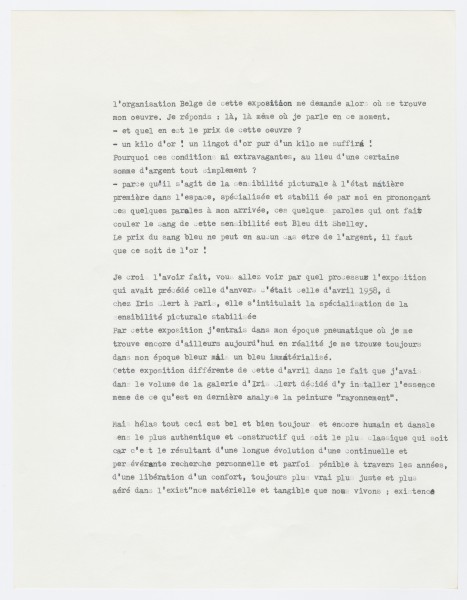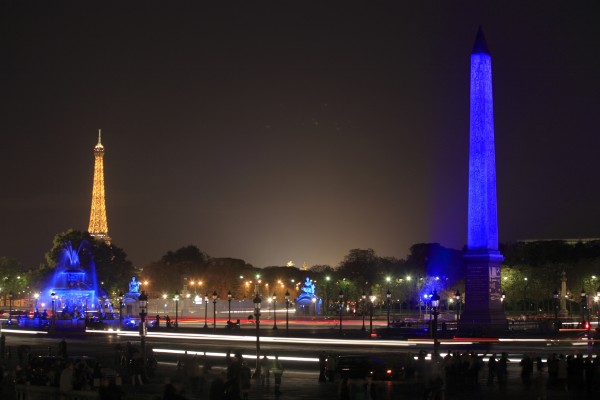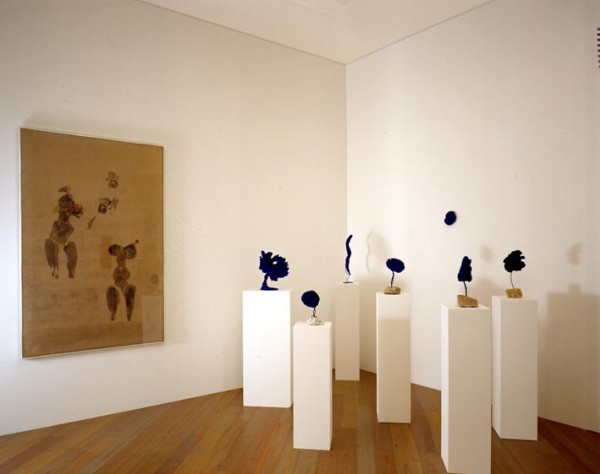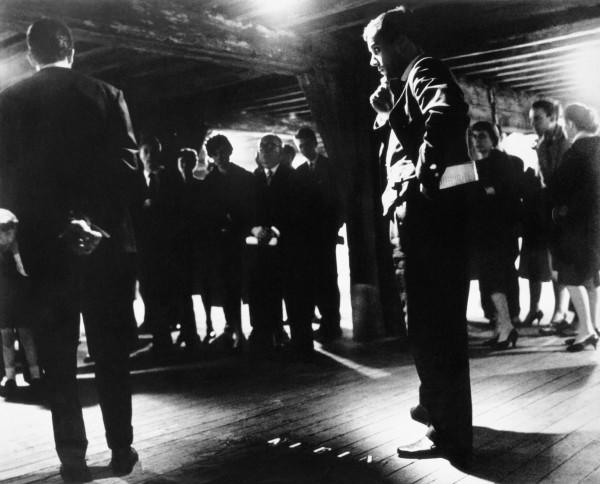"First, hardly two months ago, at Anvers, I was invited to exhibit with a group of artists made up of [Pol] Bury, [Jean] Tinguely, [Dieter] Rot, [Robert] Breer, [Heinz] Mack, [Bruno] Munari, [Daniel] Spoerri, [Otto] Piene, and [Rafael] Soto. I traveled to Anvers and instead of installing a painting or whatever tangible and visible object in the space reserved for me in the Hessenhuis exhibit hall, I loudly pronounced to the public these words borrowed from Gaston Bachelard during the opening reception:
"First there is nothing, then there is a deep nothing, then there is a blue depth."
The Belgian organizer of this exposition then asks me where my work could be found. I reply, Right here, where I am speaking – And what is the price of this work? – One kilo of gold, one kilo of pure gold will be acceptable for me.
Why these extravagant conditions instead of a normal price represented simply by a sum of money? Because, for the pictorial sensibility of the first matter, adapted and stabilized by me and pronounced in these few words upon my arrival, which made the blood of this spatial sensibility flow, one cannot demand money. The blood of sensibility is blue, says Shelley, and this is precisely my opinion. The price of blue blood cannot in any instance be money. It must be gold. And then, as we shall see later, in the analysis of the waking dream of Doctor Robert Desoille, blue, gold, and pink are of the same nature. On the level of these three it is an honest exchange.
The public is highly receptive. Taken with the new, and full of good will, it remains perplexed and awaits something, for it sees neither a painting nor any other visual phenomenon. I am resolved to comment upon my act and declare: Perhaps it seems to you that I am attempting the impossible, that I am throwing myself toward something that is inhuman .... Truth be told, I would almost wish this for myself, that is, to begin my pictorial career today through this act, but alas! All of this is indeed human in the most authentic and constructive sense, which may be the most traditional, for it is the re- sult of a long evolution, of a continual and persevering personal quest, often difficult over the years, a quest for liberation, for a forever truer comfort, a comfort more just, more airy than the material and tangible existence that we live in, an existence smothered and obscured by tech- nology, which is the false and illusory perspective of science. The true science is pure art.
For that exhibition I took my pictorial action precisely to the most extreme point of reduction. I could have made symbolic gestures, such as sweeping the space that had been reserved for me in that hall; I could even have painted the walls with a dry brush, without paint No! The few words that I pronounced were already too much. I should not have come at all, nor should my name have appeared in the catalogue. [Applause]
Yves Klein, excerpt from « Lecture at The Sorbonne », 1959
"First there is nothing, then there is a deep nothing, then there is a blue depth."
The Belgian organizer of this exposition then asks me where my work could be found. I reply, Right here, where I am speaking – And what is the price of this work? – One kilo of gold, one kilo of pure gold will be acceptable for me.
Why these extravagant conditions instead of a normal price represented simply by a sum of money? Because, for the pictorial sensibility of the first matter, adapted and stabilized by me and pronounced in these few words upon my arrival, which made the blood of this spatial sensibility flow, one cannot demand money. The blood of sensibility is blue, says Shelley, and this is precisely my opinion. The price of blue blood cannot in any instance be money. It must be gold. And then, as we shall see later, in the analysis of the waking dream of Doctor Robert Desoille, blue, gold, and pink are of the same nature. On the level of these three it is an honest exchange.
The public is highly receptive. Taken with the new, and full of good will, it remains perplexed and awaits something, for it sees neither a painting nor any other visual phenomenon. I am resolved to comment upon my act and declare: Perhaps it seems to you that I am attempting the impossible, that I am throwing myself toward something that is inhuman .... Truth be told, I would almost wish this for myself, that is, to begin my pictorial career today through this act, but alas! All of this is indeed human in the most authentic and constructive sense, which may be the most traditional, for it is the re- sult of a long evolution, of a continual and persevering personal quest, often difficult over the years, a quest for liberation, for a forever truer comfort, a comfort more just, more airy than the material and tangible existence that we live in, an existence smothered and obscured by tech- nology, which is the false and illusory perspective of science. The true science is pure art.
For that exhibition I took my pictorial action precisely to the most extreme point of reduction. I could have made symbolic gestures, such as sweeping the space that had been reserved for me in that hall; I could even have painted the walls with a dry brush, without paint No! The few words that I pronounced were already too much. I should not have come at all, nor should my name have appeared in the catalogue. [Applause]
Yves Klein, excerpt from « Lecture at The Sorbonne », 1959
| Technical | Photography in black and white |
| Dimensions | 24 x 30cm |






